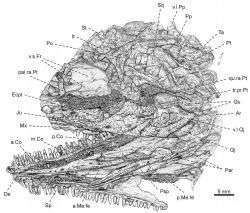Cranial reconstruction of 300 million-year-old specimens of a primitive reptile-like vertebrate

(Phys.org) —Paleontologists have provided a new cranial reconstruction of a long-extinct limbed vertebrate (tetrapod) from previously unrecognised specimens found in coal deposits from the Czech Republic.
The team of academics reviewed the cranial structural features of the Late Carboniferous Gephyrostegus bohemicus – a small animal of generally lizard-like build that lived 308 million years ago.
This early tetrapod could be the earliest example of a reptile and explain the origin of amniotes, all vertebrates that belong to reptiles, birds and mammals.
Experts from, Comenius University in Bratislava (Slovakia), University Museum of Zoology in Cambridge, The Natural History Museum in London, and the University of Lincoln, UK, have been able to study additional specimens unavailable in previous works.
Their aim was to provide an analysis of early tetrapod relationships incorporating their new observations of Gephyrostegus. Their analysis used skeletal traits across a sample of early tetrapod groups to identify the likely affinities of Gephyrostegus.
Their results are detailed in the Journal of Vertebrate Paleontology.
Dr Marcello Ruta, from the School of Life Sciences, University of Lincoln, UK, was one of the authors and produced a series of intricate hand-drawn recreations of the cranial structure of Gephyrostegus.
He explained: "Gephyrostegus has always been an elusive beast. Several researchers have long considered the possibility that the superficially reptile-like features of this animal might tell us something about amniote ancestry. But Gephyrostegus also shows some much generalised skeletal features that make the issue of its origin even more problematic. We conducted a new study that brings together data from a large number of early tetrapods. The study shows that Gephyrostegus is closely related to another group of Eurasiatic and North American tetrapods called seymouriamorphs, also involved in debates about amniote ancestry. We found some interesting new cranial features in Gephyrostegus that helped us establish this link.
"Staring at specimens for a long time down a microscope and trying to make sense of their anatomy may be frustrating and tiring at times, but always immensely rewarding."
More information: Jozef Klembara, Jennifer A. Clack, Andrew R. Milner & Marcello Ruta. 2014. "Cranial anatomy, ontogeny, and relationships of the Late Carboniferous tetrapod Gephyrostegus bohemicus Jaekel, 1902." Journal of Vertebrate Paleontology 34:4, 774-792. dx.doi.org/10.1080/02724634.2014.837055
Journal information: Journal of Vertebrate Paleontology
Provided by University of Lincoln





















